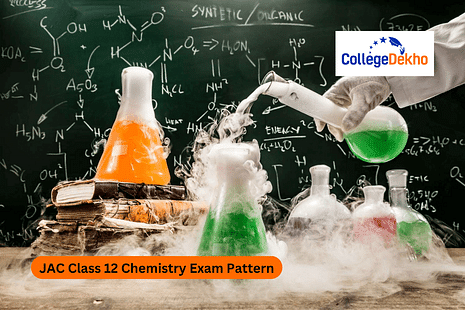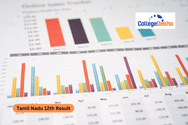

Never Miss an Exam Update
JAC Class 12 Chemistry Exam Pattern 2025:
The Jharkhand Academic Council (JAC) will upload the Jharkhand Board Class 12 Chemistry blueprint for the academic session 2025 along with the syllabus. As per the prevoius year's blueprint, the paper will have 100 marks weightage, wherein, 70 marks will be for the theory exam, and the remaining 30 marks will be based on the practical exam. Students must get a minimum of 23 marks combining both theory and practical exams to pass the JAC 12th Chemistry exam 2025. The Chemistry paper will contain different questions including MCQ+VSA/VST/SAT/LAT. The Jharkhand Board 12th question paper will comprise 40% objective questions and 40% subjective questions.
JAC Class 12 Chemistry Syllabus 2025
comprises a total of 10 chapters the marks of which are evenly distributed. The maximum weightage carrying chapter is Chapter 2 Electrochemistry which is carrying 9 marks in the exam. This is followed by Chapter 8 Aldehydes, Ketones and Carboxylic Acids which has 8 marks.
The practical exam will be based on Written test, Practical Record, and Viva.
JAC 12th Time Table 2025
is likely to be released in January 2025. The JAC 12th board exams 2025 are to be conducted in February 2025. Read the article further to know more about JAC Class 12 Chemistry Exam Pattern 2025.
JAC Class 12 Chemistry Exam Pattern 2025
The table below contains the chapter wise Jharkhand Board class 12 Chemistry marking scheme that students must check out. Read More JAC Class 12 Exam Pattern 2025
| S.No. | Unit | Topics | No. of Periods | Marks |
|---|---|---|---|---|
| 1 | Solutions | Types of solutions, Expressing concentration of solutions, Vapour pressure of liquid solutions, Raoult’s law, relative lowering of vapour pressure, Ideal and Non- ideal solutions, Colligative properties: Elevation in boiling point, Depression in freezing point Osmosis and osmotic pressure, Reverse osmosis, Hypertonic hypotonic, and Isotonic solutions, Azeotropic mixture, Abnormal molecular masses (Vant Hoff’s Factor), association and dissociation of solutes. Solubility and Henary law | 10 | 7 |
| 2 | Electrochemistry | Introduction, Conductance and related parameter, Kohlrausch law, Electrochemical cell, representation of electrochemical cell, Oxidation and reduction potentials, Types of electrode, Electrochemical series, Measurement of electrode potential (EMF), Nernst equation, Equlibrium constant and Nernst equation, Gibb’s free energy, Electrolytic cell and electrolysis, Batteries and Corrosion | 12 | 9 |
| 3 | Haloalkanes and Haloarenes |
Classification, Nomenclature, Nature of C-X bond, Methods of preparation of haloalkanes & haloarenes, Physical properties, chemical properties of haloalkanes:
1. Nucleophilic substitution reactions (SN1, SN2 including stereochemical aspects), 2. Elimination reactions 3. Reactions with metals Chemical properties of haloarenes: 1. Nucleophilic substitution reactions 2. Electrophilic substitution reactions 3. Reactions with metals. Polyhalogen compounds. | 10 | 6 |
| 4 | Alcohols, Phenols and Ethers |
Alcohol and Phenol: Classification, nomenclature, the structure of functional group.
Preparation of alcohol and phenol Physical and chemical properties of alcohol and phenol, some commercially important alcohols, and ethers: Nomenclature, preparation, and properties. | 12 | 6 |
| 5 | Biomolecules |
Introduction and classification of carbohydrates, Preparation of glucose, structure of glucose (open chain & cyclic) Structure of fructose, Disaccharides (sucrose, maltose & lactose)
Polysaccharides (starch, cellulose & glycogen), Importance of carbohydrates. Vitamins, Hormones Proteins: amino acids, structure of protein, denaturation of protein, Nucleic acids, Enzymes | 12 | 7 |
| 6 | Chemical Kinetics |
Introduction, Rate of chemical reaction (Average and instantaneous), Factors affecting rate of reaction, molecularity and rate law expression, order of reaction, units of rate constants, Determination of order of reaction:
1 Graphical method 2 integrated rate equations for zero order and first order reactions 3 initial rate method. Calculation of rate constant by: 1 Volumetric method 2 Pressure change method Half life of reaction, Temperature dependence of rate of reaction, Arrhenius equation, Collision theory of chemical reactions, Effect of catalyst | 10 | 7 |
| 7 | d-and f-Block Elements | d-Block: Position in periodic table, Electronic configuration, General properties, Variation in atomic and ionic sizes, ionisation enthalpies, Oxidation states, Trends in Standard electrode potential, Chemical reactivity and E° value, Magnetic properties, catalytic properties, formation of coloured ions, complex compounds, interstitial compounds, alloys. | 10 | 7 |
| 8 | Coordination Compounds |
Some important compounds of d- block elements : 1. K2Cr2O7 2. KMnO4 . f- Block Elements: The Lanthanoids and Actinoids. Electronic configurations, Atomic and Ionic sizes, Oxidation states, and General characteristics.
Definition of some important terms pertaining to co-ordination compounds, Nomenclature Isomerism (Structural, geometrical & optical) of co-ordination compounds, Bonding in co-ordination compounds (VBT & CFT), Werner’s theory Bonding in metal carbonyls, stability of co-ordination compounds, Importance & applications of co-ordination compounds | 10 | 7 |
| 9 | Aldehydes, Ketones and Carboxylic Acids | Aldehyde and Ketone: Nomenclature, structure of carbonyl group, methods of preparation, Physical properties and chemical properties (Nucleophilic addition reaction, Oxidation, Reduction, Reactions due to α-H, Cannizaro’s reaction, Electrophilic substitution reaction), Carboxylic acid: Nomenclature, structure of carboxylic group, methods of preparation, physical and chemical properties | 10 | 8 |
| 10 | Amines | Classification, Nomenclature, Methods of preparation, Physical and chemical properties of amines. Diazonium salts: methods of preparation, chemical properties | 12 | 6 |
| Total | 70 |
Also read: JAC Class 12 Chemistry previous year question paper
JAC Class 12 Chemistry Practical Exam Pattern 2025
The Jharkhand Board 12th Chemistry practical exam will be held for 30 marks. The latest marking scheme of the JAC Class 12 Chemistry Practical Exam is tabulated below:
| Evaluation Scheme | Marks |
|---|---|
| Volumetric Analysis | 08 |
| Salt Analysis | 08 |
| Content Based Experiment | 06 |
| Project Work | 04 |
| Class record and viva | 04 |
| Total | 30 |
Practical Examination for Visually Impaired Students
| Evaluation Scheme | Marks |
|---|---|
| Identification/Familiarity with the apparatus | 05 |
| Written test (based on given/prescribed practicals) | 10 |
| Practical Record | 05 |
| Viva | 10 |
| Total | 30 |
Download JAC Class 12 Chemistry Sample Papers 2025
JAC Class 12 Chemistry Paper Pattern 2025
The maximum time duration for the JAC Class 12 Chemistry exam will be 3 hours and 15 minutes. The JAC Class 12 Chemistry question paper is divided into two parts, Part A and Part B, where Part A will have Multiple Choice type questions and Part B will have subjective questions. Both Part A and B will be compulsory for all the students. There will be a total of 34 questions in the JAC 12th Chemistry question paper including MCQs, very short answer type, short answer type, and long answer type questions. The question paper pattern of the Jharkhand Board Class 12 Chemistry exam 2025 is as follows:No. of Questions | Type of Questions | Marks |
|---|---|---|
| Question Nos. 1 to 8 | Multiple choice type questions | 1 x 8 = 8 |
| Question Nos. 9 to 15 | Very short answer questions | 1 x 7 = 7 |
| Question Nos. 16 to 23 | Short answer questions - I | 8 x 2 = 16 |
| Question Nos. 24 to 31 | Short answer questions - II | 8 x 3 = 24 |
| Question Nos. 32 to 34 | Long answer questions | 3 x 5 = 15 |
| Total | 100 |
| Domains | Marks | Percentage |
|---|---|---|
| Remembering and Understanding | 28 | 40 |
| Applying | 21 | 30 |
| Analysing, Evaluating and Creating | 21 | 30 |
All the board exam appearing students must go through the JAC Class 12 Chemistry exam pattern and syllabus 2025 very well. This will help them prepare and score well in the JAC Class 12 Result 2025 .
FAQs
Was this article helpful?















